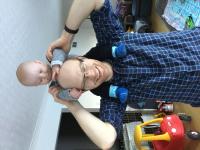Article,
The timing of language learning shapes brain structure associated with articulation
Brain Struct. Funct., 221 (7): 3591--3600 (September 2016)
Abstract
We compared the brain structure of highly proficient simultaneous
(two languages from birth) and sequential (second language after
age 5) bilinguals, who differed only in their degree of
native-like accent, to determine how the brain develops when a
skill is acquired from birth versus later in life. For the
simultaneous bilinguals, gray matter density was increased in the
left putamen, as well as in the left posterior insula, right
dorsolateral prefrontal cortex, and left and right occipital
cortex. For the sequential bilinguals, gray matter density was
increased in the bilateral premotor cortex. Sequential bilinguals
with better accents also showed greater gray matter density in
the left putamen, and in several additional brain regions
important for sensorimotor integration and speech-motor control.
Our findings suggest that second language learning results in
enhanced brain structure of specific brain areas, which depends
on whether two languages are learned simultaneously or
sequentially, and on the extent to which native-like proficiency
is acquired.
Tags
- accent
- age_of_acquisition
- bilingualism
- brain_structure
- gray_matter_density
- magnetic_resonance_imaging
- motor_cortex
- myown
- plasticity
- putamen
- skill_learning
- voxel-based_morphometry
